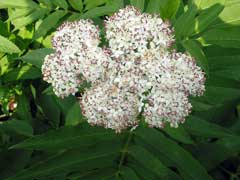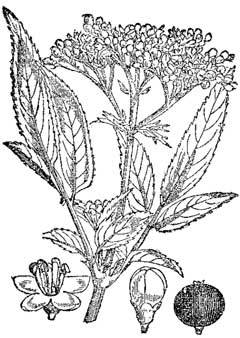 |
|
http://commons.wikimedia.org/wiki/User:Bogdan |
 |
|
Translate this page:
Summary
Physical Characteristics

 Sambucus ebulus is a PERENNIAL growing to 1.2 m (4ft) by 1 m (3ft 3in) at a fast rate.
Sambucus ebulus is a PERENNIAL growing to 1.2 m (4ft) by 1 m (3ft 3in) at a fast rate.
See above for USDA hardiness. It is hardy to UK zone 5. It is in flower from July to August, and the seeds ripen from August to September. The species is hermaphrodite (has both male and female organs) and is pollinated by Bees, flies, beetles. The plant is self-fertile.
Suitable for: light (sandy), medium (loamy) and heavy (clay) soils and can grow in heavy clay soil. Suitable pH: mildly acid, neutral and basic (mildly alkaline) soils. It can grow in semi-shade (light woodland) or no shade. It prefers moist soil. The plant can tolerates strong winds but not maritime exposure.
It can tolerate atmospheric pollution.
UK Hardiness Map
US Hardiness Map
Synonyms
Plant Habitats
Woodland Garden Sunny Edge; Dappled Shade; Shady Edge; Ground Cover; Hedgerow;
Edible Uses
Edible Parts: Fruit
Edible Uses: Tea
Fruit - cooked. It is used as a flavouring in soups etc[177]. The fruit is about 6mm in diameter and is borne in large clusters[200]. Some caution is advised, see the notes above on toxicity. Leaves are used as a tea substitute[105, 177]. Some caution is advised, see the notes above on toxicity.
References More on Edible Uses
Medicinal Uses
Plants For A Future can not take any responsibility for any adverse effects from the use of plants. Always seek advice from a professional before using a plant medicinally.
Antiphlogistic Antirheumatic Appetite Suppressant Cholagogue Diaphoretic Diuretic Expectorant Homeopathy
Poultice Purgative
The leaves are antiphlogistic, cholagogue, diaphoretic, diuretic, expectorant and laxative[4, 7, 9, 13, 21, 240]. The fruit is also sometimes used, but it is less active than the leaves[4]. The herb is commonly used in the treatment of liver and kidney complaints[4]. When bruised and laid on boils and scalds, they have a healing effect[4]. They can be made into a poultice for treating swellings and contusions[4]. The leaves are harvested in the summer and can be dried for later use[7]. The root is diaphoretic, mildly diuretic and a drastic purgative[4, 7, 9]. Dried, then powdered and made into a tea, it is considered to be one of the best remedies for dropsy[4, 240]. It should only be used with expert supervision because it can cause nausea and vertigo[9]. A homeopathic remedy is made from the fresh berries or the bark[9]. It is used in the treatment of dropsy[9].
References More on Medicinal Uses
The Bookshop: Edible Plant Books
Our Latest books on Perennial Plants For Food Forests and Permaculture Gardens in paperback or digital formats.

Edible Tropical Plants
Food Forest Plants for Hotter Conditions: 250+ Plants For Tropical Food Forests & Permaculture Gardens.
More

Edible Temperate Plants
Plants for Your Food Forest: 500 Plants for Temperate Food Forests & Permaculture Gardens.
More

More Books
PFAF have eight books available in paperback and digital formats. Browse the shop for more information.
Shop Now
Other Uses
Dye Hair Ink Repellent
A blue dye and an ink are obtained from the fruit[13, 46, 61, 115]. The root juice is used to dye hair black[4]. The leaves are said to repel mice and moles[4, 115]. Plants make a dense ground cover when spaced about 1 metre apart each way[208]. They are best used in large areas, roadsides etc[208]. Our experience to date (1995) is that the plants spread vigorously but do not form a dense cover and so do not exclude other plants[K].
Special Uses
Ground cover Scented Plants
References More on Other Uses
Cultivation details
Tolerates most soils, including chalk[200], but prefers a moist loamy soil[11, 200]. Grows well in heavy clay soils. Tolerates some shade but is best in a sunny position[1]. Tolerates atmospheric pollution and coastal situations[200]. A very invasive plant, sending up new shoots a metre or more away[K]. It can be used for naturalising in the rougher parts of the garden[233], growing well on rough banks etc[1]. The whole plant, when bruised, emits a most unpleasant fur-like smell[245]. The bark, in particular, smells like stale perspiration[245].
References Carbon Farming Information and Carbon Sequestration Information
Temperature Converter
Type a value in the Celsius field to convert the value to Fahrenheit:
Fahrenheit:
The PFAF Bookshop
Plants For A Future have a number of books available in paperback and digital form. Book titles include Edible Plants, Edible Perennials, Edible Trees,Edible Shrubs, Woodland Gardening, and Temperate Food Forest Plants. Our new book is Food Forest Plants For Hotter Conditions (Tropical and Sub-Tropical).
Shop Now
Plant Propagation
Seed - best sown as soon as it is ripe in the autumn in a cold frame, when it should germinate in early spring. Stored seed can be sown in the spring in a cold frame but will probably germinate better if it is given 2 months warm followed by 2 months cold stratification first[78, 98, 113]. Prick out the seedlings into individual pots when they are large enough to handle. If good growth is made, the young plants can be placed in their permanent positions during the early summer. Otherwise, either put them in a sheltered nursery bed, or keep them in their pots in a sheltered position and plant them out in spring of the following year. Division of suckers in spring or autumn. Very easy.
Other Names
If available other names are mentioned here
Native Range
TEMPERATE ASIA: Cyprus, Iran (north), Iraq, Lebanon, Syria, Turkey, Russian Federation-Ciscaucasia (Ciscaucasia), Armenia, Azerbaijan, Georgia, Russian Federation (Dagestan), Turkmenistan EUROPE: Czechoslovakia, Austria, Belgium, Switzerland, Germany, Hungary, Netherlands, Poland, Russian Federation (European part), Belarus, Ukraine (incl. Krym), Former Yugoslavia, Albania, Bulgaria, Greece (incl. Crete), Italy (incl. Sardinia, Sicily), Romania, Spain (incl. Baleares), France (incl. Corsica), Portugal AFRICA: Portugal (Madeira Islands), Algeria, Morocco, Tunisia
Weed Potential
Right plant wrong place. We are currently updating this section.
Please note that a plant may be invasive in one area but may not in your area so it's worth checking.
Conservation Status
IUCN Red List of Threatened Plants Status :

Growth: S = slow M = medium F = fast. Soil: L = light (sandy) M = medium H = heavy (clay). pH: A = acid N = neutral B = basic (alkaline). Shade: F = full shade S = semi-shade N = no shade. Moisture: D = dry M = Moist We = wet Wa = water.
Now available:
Food Forest Plants for Mediterranean Conditions
350+ Perennial Plants For Mediterranean and Drier Food Forests and Permaculture Gardens.
[Paperback and eBook]
This is the third in Plants For A Future's series of plant guides for food forests tailored to
specific climate zones. Following volumes on temperate and tropical ecosystems, this book focuses
on species suited to Mediterranean conditions—regions with hot, dry summers and cool, wet winters,
often facing the added challenge of climate change.
Read More
Expert comment
Author
L.
Botanical References
17
Links / References
For a list of references used on this page please go here
Readers comment
| Add a comment |
|
If you have important information about this plant that may help other users please add a comment or link below. Only comments or links that are felt to be directly relevant to a plant will be included. If you think a comment/link or information contained on this page is inaccurate or misleading we would welcome your feedback at [email protected]. If you have questions about a plant please use the Forum on this website as we do not have the resources to answer questions ourselves.
* Please note: the comments by website users are not necessarily those held by PFAF and may give misleading or inaccurate information.
To leave a comment please Register or login here All comments need to be approved so will not appear immediately.
|
Subject : Sambucus ebulus
|
|
|
|